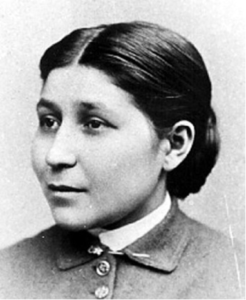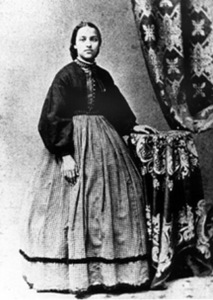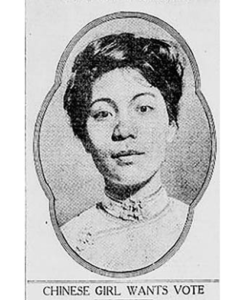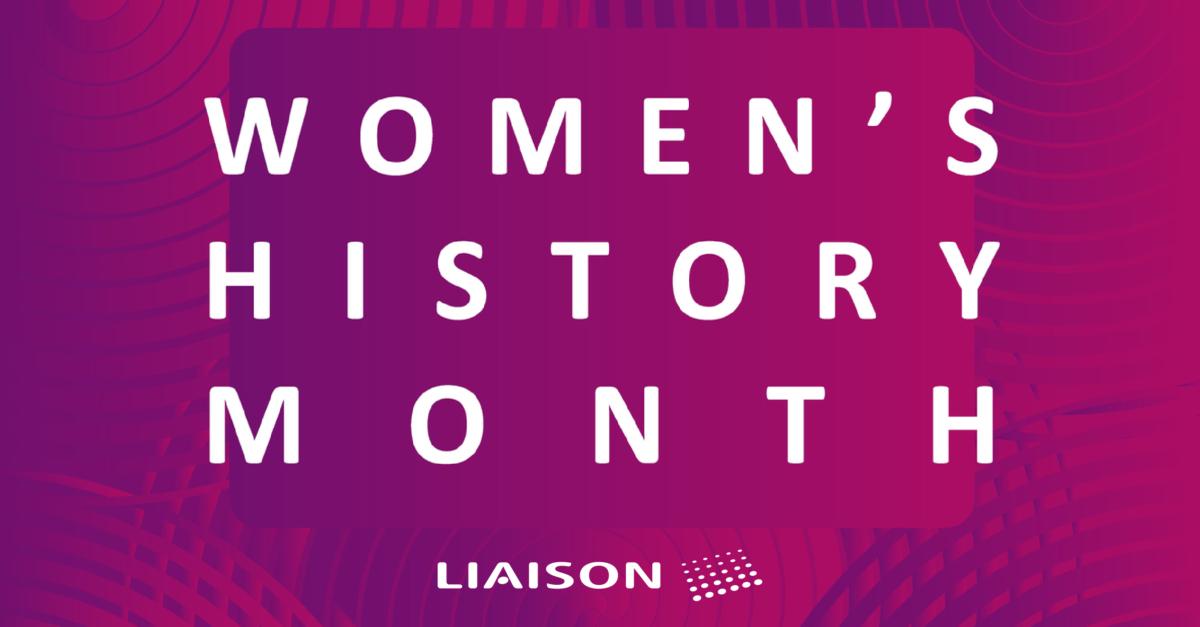As the saying goes, “Well behaved women seldom make history.” For centuries, women were banned or systematically discriminated against in their efforts to pursue higher education. It wasn’t until the 1800s that women were admitted to universities, and even then, it was in minimal numbers (in 1940, women made up less than 4% of college graduates).
Despite the tremendous odds against them, there were those who persisted—breaking through barriers and opening doors for future generations. This Women’s History Month, here are just a few of the many names to know.
Dr. Susan La Flesche Picotte: The First Native American Woman to Get a Medical Degree

Nebraska Commission of Indian Affairs (http://indianaffairs.state.ne.us)
In 1889, Dr. Susan La Flesche, a member of the Omaha tribe, became the first Indigenous woman to receive a medical degree. She graduated from Women’s Medical College of Pennsylvania (which later became part of the Drexel College of Medicine).
At 24, Dr. La Flesche became the sole doctor riding on horseback to see patients in an area that stretched more than 1,000 miles, all while suffering from chronic illness and the loss of hearing in one ear. She treated both white people and Native Americans at her own practice.
Dr. La Flesche worked tirelessly to teach her community about basic hygiene to prevent common illnesses. She spoke up about the theft of Native lands and campaigned against alcohol peddlers coming to the reservation. Dr. La Flesche would go on to open a hospital near the reservation. She famously said, “I shall always fight good and hard, even if I have to fight alone.” Today, the National Park Service honors her legacy by working with partners to turn her hospital into a clinic that will serve the Omaha tribe.
I shall always fight good and hard, even if I have to fight alone.
-Dr. Susan La Flesche Picotte, the first Native American woman to receive a medical degree.
Catherine Brewer Benson: The First American Woman to Earn a College Degree
Catherine Brewer Benson was born in Georgia in 1822. Her parents were determined she received a college education, at one point considering sending her away to pursue the limited schooling opportunities for women.
However, Catherine would never have to leave. A new school called Georgia Female College (now known as Wesleyan College) was accepting students. And in 1840, Catherine would shatter the glass ceiling as the first American woman to receive a college degree.
After graduation, she served on the school’s Alumnae Association and, in 1888, returned to speak to the graduating class, telling them: “…demands will be made upon you which were not made upon us. Your training, if you are true to it, will amply qualify you to meet those demands. No wiser blessing could I wish for you than that you may be true to every God-appointed work.”
Today, Wesleyan’s Alumnae center hosts the Benson room, named in her honor.
Mary Jane Patterson: The First African American Woman to Get a College Degree

As a girl, Mary Jane Patterson fled to Oberlin, Ohio, to escape the horrific system of slavery in North Carolina. In addition to being an abolitionist town, Oberlin’s local college allowed women and African Americans to enroll.
Despite efforts to dissuade her, Patterson insisted on pursuing the men’s course of studies, a four-year degree. In 1862, she succeeded, graduating with high honors and becoming the first African American woman to earn a college degree.
Patterson would lead a long and successful career in teaching before becoming the first African American principal at the first public high school for African Americans.
Today, her legacy lives on, with the Mary Jane Patterson Scholarship awarded to future teachers committed to addressing systemic injustice in K-12 education.
Dr. Winifred Edgerton-Merrill: First American Woman to get a Ph.D. in Mathematics
In the 1800s, math was considered a masculine discipline, and most women weren’t permitted to pursue it. That didn’t stop Winifred Edgerton Merrill, who became the first American woman to get a Ph.D. in mathematics
The road to getting her doctoral degree was far from easy. Initially, Columbia University refused to grant her access to their telescope, which was fundamental to her doctoral research.
In addition, although she was admitted to the university, women weren’t permitted to attend lectures. That meant Edgerton-Merrill had to prepare for her dissertation solely by reading books, unable to access the same resources her male peers enjoyed.
Some classmates, determined to stop her success, persuaded a professor to give her the hardest textbook possible (not realizing she had already read it from her previous studies). Despite their efforts, in 1886, Edgerton-Merrill graduated with her Ph.D. to a round of applause.
After graduation, Dr. Edgerton-Merrill tirelessly championed women’s education. She joined the committee that founded Barnard College, a New York college for women. She also founded the Oaksmere School for Girls, where she taught mathematics.
Today, her portrait hangs in Columbia University’s Philosophy Hall with the inscription “She opened the door.”
Dr. Mabel Ping Hua Lee: Suffragette and the First Chinese American Woman to Get a Ph.D

Dr. Lee was always a gifted student. At just 16 years old, she was admitted to Barnard College, where she studied history and philosophy. But Dr. Lee’s talented work extended far beyond the classroom. She was also a passionate suffragette campaigning for women’s voting rights, writing essays in the Chinese Students’ Monthly advocating for women’s suffrage. And, as a teenager, she led a march of 10,000 in a peaceful demonstration for voting rights.
Although the 19th Amendment passed in 1920, it’s important to note that it didn’t extend voting rights to all women. Many women of color, including Chinese American women, still couldn’t vote. The Chinese Exclusion Act prevented people of Chinese descent from becoming citizens. It wouldn’t be until the act was repealed in 1943 that women like Lee could finally cast their votes.
Nevertheless, Lee remained committed to women’s suffrage while attending school. And in 1921, she became the first Chinese American woman to earn a Ph.D. when she graduated with a doctorate in economics. Sadly, it’s unclear whether Lee herself got to enjoy the right to vote before her death.
Dr. Margaret Montoya: First Latinx Woman to Graduate from Harvard Law School
Harvard Law School began admitting women in 1950, but more than two decades would pass before Latinx women were represented in its class. That would all change in 1978, when Dr. Margaret Montoya, a native of New Mexico, became the law school’s first Latina graduate.
Being the first wasn’t easy. Reflecting on her experience, Montoya said, “When I was a student at Harvard, I didn’t feel Harvard was mine. I felt like a guest and, sometimes, not a welcome one.”
Since graduating, Dr.Montoya has received numerous awards, including Albany Law School’s Kate Stoneman Award for expanding opportunities for women in the legal profession. A fierce advocate for diversity and inclusion in law schools and the legal profession, she currently serves as Senior Advisor to the Executive Vice President for the University of New Mexico Health Sciences Center.
Anya Marino and Alejandra Caraballo: The First Transgender Women of Color to Teach at Harvard Law School
These two remarkable women, simultaneously shattered the lavender ceiling as the first transgender women of color to teach at Harvard Law School.
Their accomplishments are historic, considering that in 2019 less than 3% of lawyers identified as LGBT+. Both women have spent years dedicated to serving the LGBT+ community.
Their experiences as young adults profoundly shaped their desires to enter a career where they didn’t see themselves represented. When Marino was a student at Johns Hopkins, a friend of hers (who was also transgender) was killed. Caraballo credits lawyers with helping her family, showing her early on how they’re able to use the law to change people’s lives.
Both women are very aware of how much they’ve defied the odds, with transgender Americans more likely to face homelessness and unemployment. They also feel pressure to represent their community and be a voice at a table where women like them have previously not been allowed to sit.
On representation, Anya Marino said, “I would hate for us to be the last, while simultaneously being the first-that would be tragic.”
I would hate for us to be the last, while simultaneously being the first-that would be tragic.
-Anya Marino, one of the first transgender women of color to teach at Harvard Law School.
We Stand on Their Shoulders
We at Liaison believe that Women’s History Month is every month. We are grateful for the tireless efforts of these extraordinary women who fought to make education equitable and inclusive. They opened the door, and it is up to all of us to follow in their footsteps to continue to make the benefits of higher education accessible to all.
